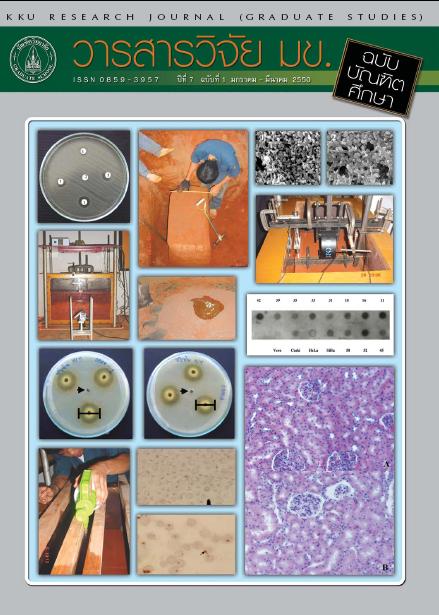Hydrodynamic Particle Diffusion in Cross Flow Microfiltration(การแพร่ของอนุภาคแบบไฮโดรไดนามิกในการกรองไมโครฟิลเตรชันแบบการไหลขวาง)
Keywords:
Microfiltration(ไมโครฟิลเตรชัน), Membrane(เมมเบรน), Fouling(การอุดตัน)Abstract
ปัญหาความยุ่งยากที่พบบ่อยในระบบบำบัดน้ำเสียแบบตะกอนเร่งคือการแยกตะกอน ซึ่งส่งผลกระทบต่อการควบคุมปริมาณการป้อนกลับของตะกอน และประสิทธิภาพของการบำบัด ในงานวิจัยนี้มีวัตถุประสงค์ในการศึกษาการปรับปรุงประสิทธิภาพของการแยกตะกอนจุลินทรีย์ในระบบบำบัดน้ำเสียแบบตะกอนเร่งโดยใช้ไมโครฟิลเตรชันเมมเบรนแทนการใช้ถังตกตะกอน สารป้อนที่ใช้เป็นน้ำเสียจากบ่อเติมอากาศของระบบตะกอนเร่งโรงงานอาหารทะเล ส่วนแรกของการทดลองเป็นการศึกษาอิทธิพลของตัวแปรต่างๆที่มีต่อค่าฟลักซ์และประสิทธิภาพของระบบการกรองที่ใช้เซลลูโลสไนเตรท การทดลองทำในช่วงค่าความดัน 5-15 psi ความเข้มข้นสารป้อน 1500-3500 mg/l อัตราการไหล1.25-1.75 Lpm และขนาดรูพรุนของเมมเบรน 0.1-5 micron พบว่าการกรองให้เพอมิเอทฟลักซ์ในช่วง 9.38-27.58 L/m2.hr ซึ่งทุกการทดลองมีประสิทธิภาพในการกำจัดของแข็งแขวนลอย > 99% และลดค่าซีโอดีของน้ำได้ >58.1% และสภาวะที่ให้ค่าฟลักซ์สูงที่สุดคือการดำเนินการที่ ความดัน 5 psi ความเข้มข้น 1500 mg/l อัตราการไหล 1.75 Lpmและขนาดรูพรุน 5 micron โดยค่าเพอมิเอทฟลักซ์ที่ได้จากการทดลองนี้คือ 27.58 L/m2.hr ซึ่งประสิทธิภาพในการกำจัดของแข็งแขวนลอยสูงถึง 99.73% และเป็นผลพลอยได้ทำให้ลดค่าซีโอดีของน้ำได้ถึง 58.1% การทดลองส่วนที่สองเป็นการตรวจสอบรูปแบบการอุดตันบนเมมเบรนกับโมเดลการอุดตันมาตรฐาน ซึ่งจะทำให้สามารถกำหนดวิธีการล้างที่เหมาะสมที่ช่วยยืดอายุการใช้งานของเมมเบรน พบว่าเกิดการอุดตันบนเมมเบรนเป็นแบบ cake filtration ซึ่งสอดคล้องกับผลที่ได้จากการดูด้วยกล้องจุลทรรศ์แบบส่องกราด (SEM) โดยการล้างเมมเบรนแบบล้างสวนกลับเหมาะสำหรับการอุดตันแบบดังกล่าว
Major problems often encountered for the activated sludge system in waste water treatment is sludge filtration. This problem affects control of the sludge return and leads to low treatment efficiency. The objectives of this research was to improve the efficiency of the activated sludge system by using membrane microfiltration instead of a conventional sediment tanks. The waste water feed came from the aeration tanks of an activated sludge system of a seafood factory. In the first part of the experiment, study of the effects of transmembrane pressure, feed concentration, feed rate and membrane pore size on the flux value and the efficiency of the system were conducted.Their values were ranging from 5-15 psi, 1500-3500 mg/l, 1.25-1.75 Lpm and 0.1-5 micron, respectively. The results revealed that the filtration permeate flux values were 9.38-27.58 L/m2.hr. It can remove suspended solid more than 99% and reduce COD more than 58.1%. The highest permeate flux was obtained at the transmembrane pressure of 5 psi, the feed concentration of 1500 mg/l, the feed rate of 1.75 Lpm and the pore size of 5 micron for cellulose nitrate membrane. At the permeate flux value of 27.58 L/m2.hr it can remove 99.73% of the suspended solids and 58.1% of COD. In the second part of the experiment, it was found that after the crossflow microfiltration process, the outcome resulted in cake filtration fouling and it can be washed using a backwash process to extend shelf life of membrane. The result of this cake filtration fouling was confirmed by SEM.



